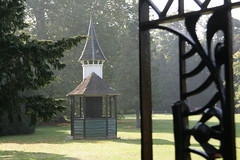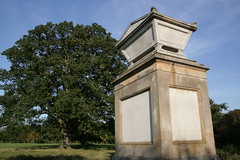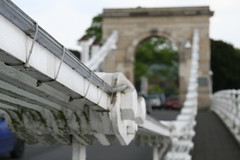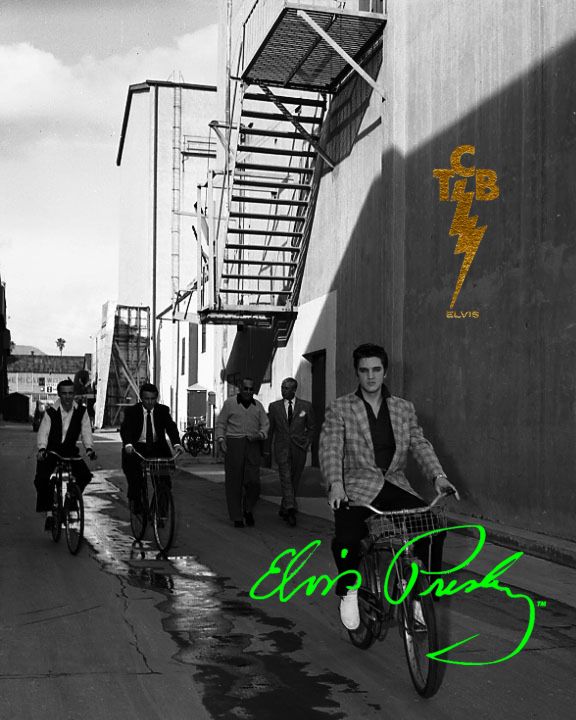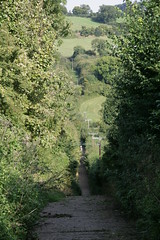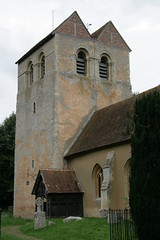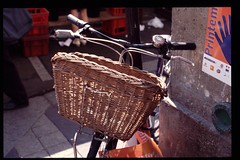Sunday, 28 September 2008
A minor accident statistic
So I set off in high spirits for a good long stretch.
However, as I came into Windsor, the front wheel hit a rut at an awkward angle, which caused me to swerve. I braked hard to avoid going into the traffic, and flew straight over the handlebars. Not exactly good braking technique; and certainly not the most dignified way to come to a rapid halt.
I'm proud to say that I then managed to execute quite an elegant three-point landing, on my forehead and knuckles. Thanks to the helmet, there was no serious damage done. I am a bit grazed and bruised, and I broke the face of my watch, but the bike landed on top of me, so it is fine.
At first I felt a bit shaken though, so I took my time getting started again, with every intention of continuing the ride. However, after the third person had stopped to check that I was OK, and offer me help, I was holding more baby-wipes than I knew what to do with, and I had come to the conclusion that things must look a lot worse than they really were. So I decided it was better to go home and get myself cleaned up.
I ended up covering just 17 miles, on a day when I intended to do about twice that. I am disappointed that I didn't get to take more advantage of such lovely weather. I clearly need to improve my braking technique, but the more important lesson from the whole experience is that three complete strangers went out of their way to show concern and offer support. Their help wasn't neccesary, but that isn't the point: by taking the trouble, they turned what could have been a bad experience into a very positive one.
Saturday, 27 September 2008
Memorial to Thomas Gray
The parts of the circuit nearest home are very familiar, while the rest covered ground that I have cycled before, but not for a while.
I seem to have picked quite a popular route, and saw a lot of other cyclists out for ride on a lovely autumn evening. In retrospect perhaps I could have avoided quite so many busy roads, and uninteresting suburbs. On the other hand, Burnham Beeches was looking very fine, with low sun filtering through the trees; and by the time I crossed back over the Thames at Cookham, the rich, low sunlight made the river look like molten metal.
On balance it wasn't such a bad mix.
How to....

The Guardian has been publishing a series of "how to" booklets this week on different kinds of writing (Journalism, Children's books, Poetry, Biography, etc.), but, curiously, nothing on how to write a cycling blog. however, there is quite a lot of advice out there on the internet about blogging in general. You can google it as well as I can, so I'm not going to suggest anything specific, except for this, which seems pretty sound.
Friday, 26 September 2008
Accident statistics
The Department for Transport has just published the accident statistics for 2007.
The number of pedal cyclists killed or seriously injured works out as one every 500,000 journeys, or one every 1.9million kilometres (one every 1.2million miles).
The risk of death is similar for a pedestrian and a cyclist, over the same distance, but a pedal cyclist is around three times more likely to be killed on an average journey than a pedestrian because the average bicycle journey is longer than the average walk.
Pedal cycle casualties have decreased by 34% compared to ten years ago, but remain at a similar level to 2006, despite an 8% decrease in cycle traffic - in other words, the rate has increased by 9%.
The number of pedal cycle fatalities has fallen by 7% from 146 in 2006 to 136 in 2007, and shows a 27% decrease from the number 10 years ago (the actual baseline they use is in an average of the figures from 1994–98).
The full report is here
Thursday, 25 September 2008
Back on the bike
The bike shop have done a good job, and the bike seemed to be running very sweetly. I don't suppose that's because there is anything magic about the new part: more likely because it has now all been set up properly.
I wish I could say the same for myself. It's only been a week away from the bike, but I definitely felt off my best form, and I couldn't possibly describe my legs as running sweetly.
The ride out involved quite a steep climb, but the lanes back from Handy Cross to Little Marlow, were a real treat. It's a stretch of a couple of miles, downhill all the way, through lovely woodland, and I went past a surprisingly large number of pheasants.
Monday, 22 September 2008
Solutions to a "Helmet Hair" problem
According to a survey commissioned by Cycling England, and reported in the Independent, 27% of women are put off cycling to work by fear of "helmet hair". It doesn't say whether many men share this concern, which until ten minutes ago, had never even occured to me. But perhaps we should be worried too.
Thankfully, as ever, Bike Forums has been ready with answers for the last three years. If I want to be sure that people don't point at me and laugh at my helmet hair, all I have to do is pick one of their many solutions:
- Shave my head
- Grow a ponytail
- Wear a bandana
So, why are all those people still pointing and laughing?
Sunday, 21 September 2008
City cycling and advocacy
It is an easy read, and informative, but very much a book of its time, and entertaining partly for a slighlty old-fashioned style.
Today I found myself in a bookshop, and out of curiosity I bought a copy of Richard Ballantine's latest book, City Cycling.
I've only skimmed the book so far, but Mr Ballantine has clearly lost none of his enthusiasm over the last 35 years, while book production has advanced. It seems to me that he puts over some important principles in an entertaining way. However, I think he see his main audience as people who have not yet tried cycling, or at least not in the recent past. As a result he puts a lot of effort into advocating that readers take it up. The spirit is captured by the strapline: "Get fit / save time / save money / save the planet".
For this target audience he seems to cover most of the bases: how to buy a bike, security, handling skills, maintenance and repairs.
But personally I find it hard to engage with the advocacy running through City Cycling. The problem, I suspect, is that I no longer feel that I am part of the audience that he is mainly concerned with - simply because I have already taken up cycling. My priority is now to make sure that I stick at it, and keep putting in the effort.
I'm too old and decrepit to be pursuing a goal of outstanding athletic achievement, and unfortunately, faced with the choice of going for a ride, or not going, then none of these arguments that it will save time, save money and save the planet really cuts it as a good enough reason to get out of the armchair.
As my family knows well, the best way of persuading me to get the bike out of the shed and go for a ride is "you'll enjoy it"; or "it will make you feel better". When I really don't feel like going for a ride, I can still talk myself out of the chair to go in search of a bit of an adventure, to work off a bit of stress, to see if I can beat a previous performance, or just to keep my various graphs moving in the right direction.
It is for these reasons that cycling is gradually becoming part of my routine. At times like today, when I can't get out on the bike because of mechanical problems, I am finding that I miss it.
So if you are considering taking up cycling, particularly cycling in an urban context, then I suggest you take a look at Richard Ballantine's book. I hope you find that he provides useful advice, in an entertaining way. If, like me, you feel that you have progressed to the next stage, then tell me whether I am being unfair to wonder why so many advocate that we take up cycling in the first place; while fewer seem to realise that subsequently we still need to be encouraged to go for a ride?
Wednesday, 17 September 2008
Question on insurance
Bikes have feelings too
 I'm not going to be doing any riding over the next few days, because I've broken the rear derailleur, and for one reason and another I cannot get it fixed until next week. I took off the rear wheel a couple of evenings ago, to check that the puncture repairs that I had done on the side of the road were looking OK. I think I must have put the wheel back on crookedly, because as soon as I pressed on the peddle there was a crack, and the rear derailleur fell off. It's all looking very sad and I feel sorry for the poor bike. I suspect I could fit a new derailleur but I'm not sure that my skills are sufficient to get all the adjustments right. So I've booked the bike into the local bike shop so she can have some professional surgery.
I'm not going to be doing any riding over the next few days, because I've broken the rear derailleur, and for one reason and another I cannot get it fixed until next week. I took off the rear wheel a couple of evenings ago, to check that the puncture repairs that I had done on the side of the road were looking OK. I think I must have put the wheel back on crookedly, because as soon as I pressed on the peddle there was a crack, and the rear derailleur fell off. It's all looking very sad and I feel sorry for the poor bike. I suspect I could fit a new derailleur but I'm not sure that my skills are sufficient to get all the adjustments right. So I've booked the bike into the local bike shop so she can have some professional surgery.Sunday, 14 September 2008
A fine ride with cake
The route is well signed on the ground, but it took some finding on a map. As far as I can tell, the only place it has been published on the interweb is in a fairly obscure Buckinghamshire transport strategy document. Which is odd, because it is a fine route through lovely countryside, with a choice of good places to stop off on the way. Whoever first laid it out had a good eye for landscape, but unfortunately either they had a bit of a blind spot for hills, or a wicked sense of humour, because there are some pretty challenging climbs, including this steep farm track linking a couple of roads north of Marlow.
I traced the route on the GPS, and I've tagged it on Open Streetmap, so it will appear towards then end of this week when the cycle map is re-generated. But regular visitors to Tlatet, will, I am sure, have an urgent need for more detail.
So here we go. In outline the route climbs to the north of Marlow, as far as Frieth, then turns west, through Fingest, and south through Hambleden. In the past I've taken the road through Bovingdon Green out of Marlow, and the A4155 from Hambleden back, but this route starts out along the B482 on the way out, and on the return uses narrow lanes to climb through Rotten Row to Marlow Common, before dropping back into Marlow. It also takes a slightly different back route through Hambleden.
As far as the fauna goes, the highlights today were a small deer that crossed the road about 100 yards in front of me; and a number of large birds of prey, flying low across the road - presumably searching for small rodents in the fields.
When I reached Hambleden, at about 4pm there was a choral concert in the church, and they were serving tea and cakes in the churchyard. I joined a small group sitting outside in the sun, listening to the music through the windows. I'm not a great tea drinker, and the best I can say about the coffee was that it was warm, brown, and wet; but the selection of cakes was awesome. I finally settled for some cinammon flapjack - which was delicious - but it was a tough choice.
By the time I had made my way to Marlow and home, the whole ride turned out to be just over 30 miles (the loop itself is about 15 miles from Marlow and back).
Next time I can't rely on such a lovely afternoon, and cakes in Hambleden churchyard, but I'll be back, because this is one of the best routes that I've found at around that length. Next time I might even manage to do a bit better on the steep hills. There are plenty of good places to stop for a break; and it looks to be popular with cyclists (several passed me on the hills). So it seems odd that the route isn't named and publicised more widely.
Or perhaps I've missed something. If so, please let me know.
Roundabouts revisited again

disgruntled asked, on an earlier post, what answers the Cyclecraft book gave to the problems of negotiating multi-lane roundabouts. This is my attempt to summarise quite a rich mine of advice and suggestions. Before I start let me say that there are about four pages in the book on multi-lane roundabouts alone, and more than two hundred pages on different aspects of cycling: it is well worth studying the original source.
The first point I take from the book is that the best route for a cyclist to take round a multi-lane roundabout is much the same as a car would take: using the outer lane to turn left (we are in the UK); the centre lane to go straight ahead, and the inner lane to turn right.
The second point is that the main dangers to a rider on a multi-lane roundabout are when passing an entrance (because cars entering the roundabout may not see you); and when jockeying for position on the roundabout itself (because of the different speeds of cars and bike).
I think we had pretty much figured those out already, though I hadn't really taken on board the fact that, despite the problems of jockeying for position on the roundabout itself, you definitely do not want to be riding in the outside lane, when you pass an entrance with multiple lanes of cars joining the roundabout.
Reading on, the advice gets even more interesting.
In his book, John Franklin works through three different scenarios: for turning left, carrying straight on, and turning right. Much of the advice seems to centre on making sure that you maintain control of your lane. You do this, firstly by taking position early on approach to the roundabout: in the inner, middle, or outer lane depending on which direction you are going to head. If there are only two lanes on approach, then the best position for going ahead is the right hand (outer) edge of the left hand (inner) lane. Otherwise it is the centre of the middle lane. If turning left or right, then take up the centre position in the appropriate lane.
For me, some of this is counter-intuitive, but on reflection it makes good sense. The temptation is to make it easier for cars to pass, but in reality the best strategy is to make it clear that they shouldn't.
The same principle seems to apply to the advice on turning left: use the outer lane of the roundabout (left side), but keep well away from the kerb. The book specifies about 7 feet, or 2 metres, which sounds like almost the width of lane that a car needs - i.e. clearly enough to stop anyone passing in the same lane, and not enough for anyone to cut between you and the kerb.
For turning right, the advice is to use the outer edge of the inner lane around the roundabout: again seemingly with the intent of controlling the lane, without letting anyone overtake between you and the kerb. The book states the obvious when it says you need to signal clearly when starting to spiral out of the roundabout, but I imagine that by taking this position on the outside of the lane you are already indicating your next move to any following drivers.
Other pieces of advice include being ready to take evasive action, while not making any sudden changes of direction. Not to try and change gear while negotiating the roundabout (unless you have to drop speed suddenly), but to chose a gear beforehand that allows a relatively high speed, being ready to put on a spurt of speed if necessary.
He also describes some negotiation techniques to show drivers when you are determined to make a move (such as taking up a position on the edge of the lane you intend to enter, targeting a particular driver to make way for you, and engaging eye contact). Finally, he makes the point that on very busy roundabouts you can sometimes use other vehicles as a shield, particularly when they have made way for you to change lane.
In summary, the book doesn't pretend that this is easy, or that there is a single simple answer. I think we had already worked out that the best route for negotiating a complex roundabout on a bicycle was the same as the one that other vehicles use. At my current level of expertise, my new lessons are that I should show more clearly that I intend to maintain control of the lane, and I must resist the temptation to keep out of everyone's way by heading for the kerb. I could also do with practising techniques for negotiating with drivers for access to a lane, and in handling complex manouvres at speed. I don't really get how to use other vehicles as a shield, but I will leave this for another day.
Finally, thanks to everyone who has been joining in, particularly "disgruntled" who prompted me to try and set this down without losing any of John Franklin's clarity. I hope it makes some kind of sense.
Friday, 12 September 2008
Some timely advice
Thursday, 11 September 2008
Roundabouts revisited
A couple of weeks ago Just Williams drew our attention to Cyclecraft by John Franklin. Yesterday I was in town to sort out some stuff, dropped into the bookshop and bought myself a copy, along with a book of local cycle routes.
Cyclecraft has no less than 16 clear and informative pages on how to negotiate a roundabout on a bike. The book describes the problems, and recommends plausible solutions. It nicely considers the issues from the perspective of both the cyclist and the car driver. I have already picked up on a couple of things that I could be doing better, and will no doubt discover more on further reading.
The rest of the book looks to be of the same high standard, and my first impression is that Just Williams was spot on when he said that Cyclecraft "deserves to be read slowly and thoughtfully".
Yesterday evening I also explored one of the routes from my other new book (or at least a large part of it). It took me onto some unfamiliar roads, but the nights are starting to draw in, so a lot of it was in the dark. That rather detracted from the point of exploring new ground. However, it was a very satisfying stretch of 25 miles, including a number of roundabouts, all of which I negotiated safely and confidently (thanks, I admit on this occassion, to very light traffic rather than my study of Cyclecraft).
Monday, 8 September 2008
Sod's law proved wrong
However, several days of crummy weather, and various domestic comings and goings meant that by this morning I hadn't been on the bike all week, and I was beginning to pace up and down like an animal in an old-fashioned zoo.
So this morning I decided to bunk off work for the day, and get out for a decent ride.
I headed over Winter Hill to Marlow, then up into Buckinghamshire.
The first few miles were the same route that I use to race Walter Y'Geaux, my alter ego, on the GPS; and it was a pleasant change to take it a bit more slowly. Then I negotiated Marlow, and started the long climb up to Frieth. The first part, to Marlow Common is quite challenging and I was puffing and panting a bit, but quite pleased to be keeping up a decent pace, until a gentleman, who must have been at least ten years older than me, passed at about twice the speed, with a cheery "good morning", and little sign of effort. You can't get too complacent on a bike.
From Frieth I made my way to Fingest, which is mostly downhill. I stopped to look at the church, which has an impressive 12th century tower. Apparently there is only one bell, although there is space for a whole peal. According to the leaflet in the church, local tradition holds that a previous rector lost the rest of the peal in a bet with a neighbouring parish.
After Fingest, I went on to Turville. For anyone who doesn't know, this is all very pleasant countryside, and Turville was the location used for recording the Vicar of Dibley. Then I headed south again, towards Hambleden to join the main road back to Marlow and then home.
After last week's puncture, I had made a special trip to the bike shop to stock up on patches and a new inner tube. Sod's law dictates that if I hadn't done this, then without the means to repair it, a puncture would have been almost inevitable; and because I was well prepared another puncture was highly unlikely.
Well Sod is wrong.
Just after Turville the back tyre went again; and out came the new repair kit. While I was fixing it, another cyclist stoppped to check that I had everything I needed, which was nice of him, but I'm beginning to get quite practiced at this now. Somebody is bound to ask the question I asked myself - "did you make sure the nail wasn't left in the tyre?". And the answer is, yes, and the new hole was in a different place - it was definitely a different nail this time.
All in all, though, it was a lovely day for bunking off, and a very pleasant outing. The weather was mostly overcast, veering between "almost raining" to "almost sunshine". In all I covered just over 40 miles, which isn't too shabby, and logged a few minor roads that haven't appeared on Open Street Map yet. There were also a number of signs for local cycle routes that I don't remember seeing before, so there is a decent excuse for going back to do some more exploring.
Tomorrow, though, I will have to do some real work.
Sunday, 7 September 2008
It's PC gone mad

Phone hoaxer claims he's Inspector Morse's sidekick
A man claiming to be Inspector Morse's sidekick Lewis has made a slew of hoax phone calls to local addresses.
Over the weekend police received nine reports relating to suspicious telephone calls in the Dedworth and Old Windsor area.
A police spokesman said: "In all cases the call was made by a man, who claims to be DCI Lewis, of Morse fame, from Thames Valley Police. He claims there is trouble with youths in the area and he would be grateful if the call recipient could assist him by looking out of an upstairs window, to see if there is any youth activity in that area."
I suppose it's not funny really, but I couldn't resist the headline. And for what it's worth, this article from the Maidenhead Advertiser is captured from the new Google "Chrome" browser - which I installed this evening: it looks pretty good.
Friday, 5 September 2008
Wordle

Crummy weather means no outings on the bike, and hence nothing out there in the real world to post about.
So instead, here is a cloud from Wordle, based on earlier content. With thanks to Town Mouse for the pointer, and for a much better sample.
Tuesday, 2 September 2008
Sometimes you just can't see the wood for the trees

Open Street Map, and its spin-offs are not the only mapping initiatives that are using volunteers to put mapping data into the public domain. The woodland trust is running an Ancient Tree Hunt which aims to "find and map all the old, fat trees across the UK".
Their interactive map is here, they have forms where you can record an ancient tree, and submit it for verification and adding to the map.
It looks as though there are a heck of a lot of ancient trees out there that need a hug.
Monday, 1 September 2008
Punctures
On the assumption that punctures are more likely in towns, I guess people who commute by bike experience more, unless they take some kind of preventative action. On my previous bike, after several puncture in rapid succession, I changed to more knobbly tyres, and put a kevlar strip inside the tyre, and never had another puncture. On this bike, covering longer distances, with a puncture every 650 miles, I'm inclined to put up with the inconvenience.
On a longer outing I try to remember to take a set of tyre levers and some adhesive patches with me to do a temporary fix. On a shorter ride I don't normally bother. So far that has worked out fine - all my punctures have been on a longer journey when I've had the repair kit with me, and I've managed to patch things up well enough to get home. I'm normally left with a slow leak, and a tyre that keeps going soft. So when I get a chance, I have subsequently replaced the inner tube. On the only occassion when the temporary fix failed I was only half a mile from a bike shop, so it was easy to replace the inner tube there and then. If all else fails I'm rarely more than an hour or two from home by foot and public transport, but I've not had to resort to that - yet.
So after the helpful responses to my question on roundabouts, I'm left wondering how this compares with other experiences and other approaches. Bearing in mind the kind of riding that I am doing, am I lucky, or unlucky to be getting a puncture every 650 miles or so? Is there a better solution than a temporary fix with an adhesive patch?
Nine inches
But when it comes to measuring weight, distance and volume, I still think in stones and pounds; inches, feet and miles; pints and gallons. And so, I am happy to say, does the NHS Direct Body Mass Index Calculator.
This is a web page, where you plug in your weight (in stones and pounds); and your height (in feet and inches), and it works out your BMI, then tells you what it thinks.
Until this morning it has been a bit rude, frankly. But having lost a few pounds over recent weeks, this morning it is being much more polite. To paraphrase a little, the underlying message has changed from "we are disgusted at the disgraceful state you are in", to "we are disapponted that you are not taking better care of yourself".
I count this as progress, and I'm feeling mildly pleased that there is a pay off from a combination of taking more exercise, and my wife keeping a careful eye on my diet.
However as far as I can make out, I am still about 9 inches short of the ideal height for my weight. So no slap up meal to celebrate - the programme continues....
